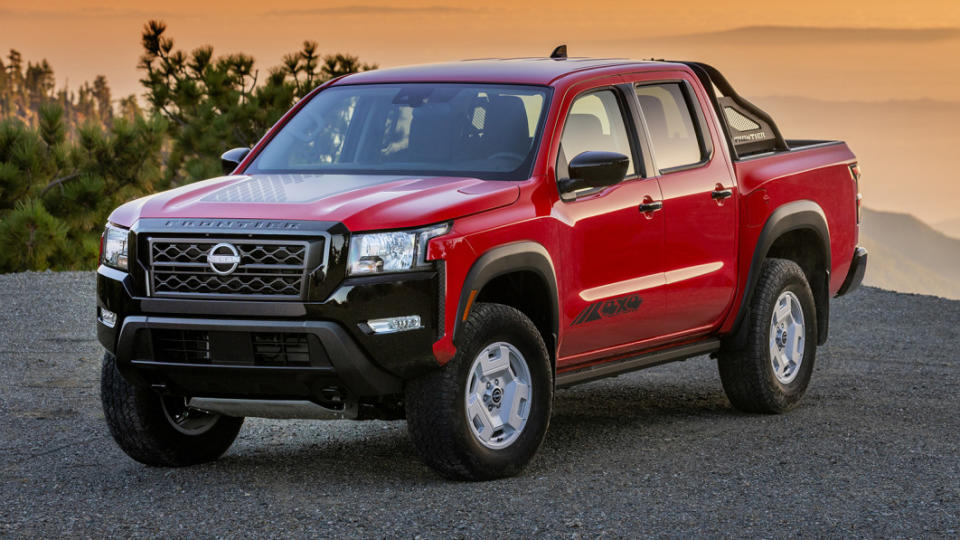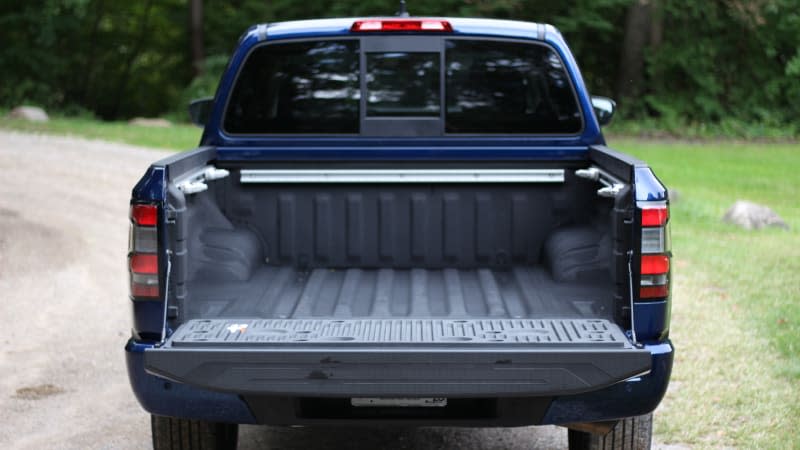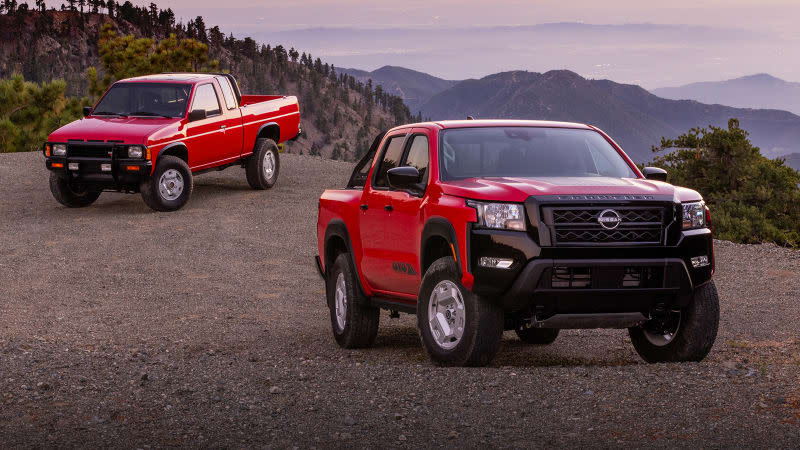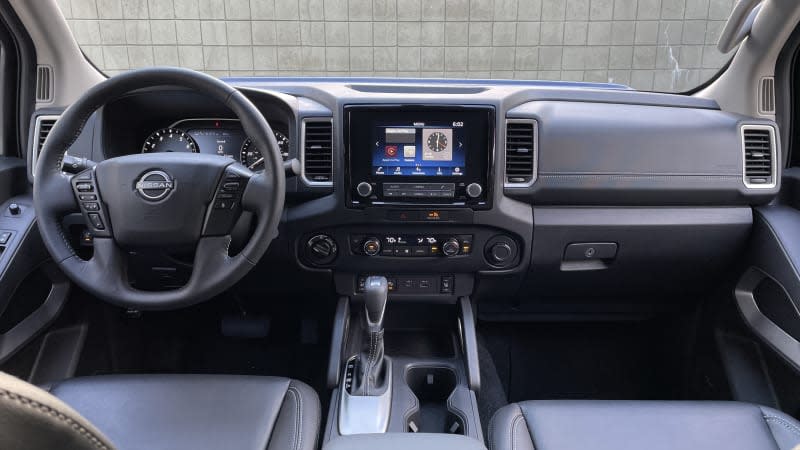2024 Nissan Frontier Review: The driver's choice in an array of configurations

Pros: Refined V6; excellent steering and handling; two cab sizes; long bed available with crew cab; small maneuverable size
Cons: Lack of powertrain options; small interior; mediocre fuel economy
The midsize pickup truck segment is seeing an influx of completely new models employing turbocharging and simplified cab configurations. By contrast, the 2024 Nissan Frontier is sticking with a decidedly old-school approach, and while it might not be the perfect truck answer for everyone, it might be for a select few. Not only is it old-school in its powertrain, cab/bed offerings and some of its features, but the truck itself is really a heavily revised version of its rather long-lived predecessor. But as we mentioned, that’s not entirely a bad thing.
In many ways, the Nissan Frontier is the driver’s choice for a midsize pickup truck (well, at least on-road). The handling is quite good for a pickup, and it’s bolstered by surprisingly good steering feel that puts some cars to shame. It’s also comfortable, and its smooth naturally aspirated, 310-horsepower V6 provides some added refinement that the turbo four-cylinder engines of competitors can’t quite match. It’s the standard engine, too, which sweetens the deal of the base models. Additionally, the Frontier offers a variety of configurations not available on several rivals, including an extended cab and the option of pairing a long bed with the crew cab. The Toyota Tacoma is the only other midsize truck to still offer those.
With that said, the Frontier doesn’t offer high-performance off-road variants like those from Toyota, Ford, Chevy and Jeep, nor does it have higher-performance engine options like Toyota and Ford. Nor is there a more luxurious variant to match the GMC Canyon Denali. The V6’s fuel economy lags behind the turbo four-cylinders, too, albeit not by a huge amount.
Whether the Frontier is right for you depends on your priorities. If you really value driving experience, small size and being able to get a specific body type, you can’t go wrong. But if you’re looking for fuel economy, off-road performance or prefer something a bit bigger, you may want to consider the competition.
Interior & Technology | Passenger & Cargo Space | Performance & Fuel Economy
What it's like to drive | Pricing & Trim Levels | Crash Ratings & Safety Features
What's new for 2024?
The Nissan Frontier gets a couple new trim and package additions. The SL trim has been added as the range topper with most features included as standard, including heated leather seats and wheel, a 10-speaker sound system and a sunroof. There’s also the new Hardbody Edition package (pictured below) for the SV trim. This one comes with a bunch of exterior additions such as vintage graphics, a style bar and, most notably, special 17-inch alloy wheels that look just like the distinctive ones from the old Nissan Hardbody pickup truck.
What are the Frontier’s interior and in-car technology like?
This is one of the areas where the Nissan Frontier shines. It has a chunky, squared-off dashboard to match its rugged exterior, and the plastics are impressively high-quality and tight fitting. The Pro-X and Pro-4X models also offer the option of vibrant red stitching, embroidered logos and leather-wrapped steering wheel and shifter (pictured in the smaller photos above). On top of all that, all Frontiers come with highly comfortable seats that offer plenty of support. Visibility is superb, too, with tall windows and low sills.
All Frontiers also get at least an 8-inch touchscreen infotainment display, with a 9-inch unit on higher trims (pictured). They all use the same interface, which has minimal menus and large icons that make it easy to navigate, plus Apple CarPlay and Android Auto are standard. Both screens are bright, clear and responsive. We're also very pleased that climate and stereo functions are easy to use with traditional buttons and knobs. Four USB ports are standard, with two each in the front and rear cabins.
How big is the Frontier?
On the outside, the Frontier is the smallest truck in the midsize segment. Lengthwise, it has the shortest wheelbase and overall length (even when comparing crew cab/long bed configurations), and it's the narrowest. Its overall height is in the middle compared with other midsize trucks.
Speaking of cab and bed options, the Frontier can be had in either an extended cab (King Cab) or a full four-door crew cab. The King Cab comes only with the longer bed option (72.7 inches), but the crew cab can have either the short (59.5 inches) or long bed choices. The combination of crew cab and long bed is a feature only shared with the Toyota Tacoma. We take a deep dive into the Frontier bed in this driveway test.
Inside, the Frontier is on the smaller side of the spectrum, which is understandable considering its smaller exterior dimensions. By the numbers, it's an inch or two smaller than most, though head room and shoulder room are pretty solid. Legroom is really where things are on the tight side. The front occupants should feel fairly comfortable, but if you're on the tall side, you may find insufficient seat travel. The lack of a telescoping steering wheel is likely the bigger deal, regardless of your height. Adults can fit in the rear seats of the crew cab and be comfortable for short jaunts, but the lack of leg room will make them uncomfortable on long trips. The upright seat back doesn't help, either. Pretty much every other truck in the segment offers more generous rear accommodations. The extended King Cab, meanwhile, operates on a more even playing field with its competitors because you're just dealing with varying degrees of severely cramped. The Frontier King Cab's rear seats are only suitable for some pets or friends who are really small (or really need to get somewhere). It’s a rare thing, now, too, as only the Tacoma still offers an extended cab model, and that one doesn’t have rear seats at all.

What are the Frontier’s fuel economy and performance specs?
The Frontier offers only one powertrain: a naturally aspirated 3.8-liter V6 paired with a nine-speed automatic transmission. Output is 310 horsepower and 281 pound-feet of torque, which is strong, but isn’t quite the class-leader it once was. It’s tied in power with the high-output Colorado and Canyon, and behind the hybrid engines in the Tacoma, and the turbo V6 in the Ford Ranger Raptor. Torque now falls behind nearly every turbo engine in the segment, including some standard ones. As usual, there's a choice of rear-wheel drive or four-wheel drive, and both come standard with a limited-slip rear differential.
Unsurprisingly, the more frugal of the two options is the rear-drive Frontier. It gets 18 mpg in the city, 24 mpg highway, and 21 mpg combined. Four-wheel drive brings the numbers down to 18/23/20. The Pro-4X drops a little farther to 18/22/19. That puts it on par with some key competitors such as the Honda Ridgeline and Jeep Gladiator, but a bit behind most versions of the Ford Ranger and Chevy Colorado.
As for carrying stuff, the Frontier has towing and payload capacities at the back of the pack. Towing is the worst in segment at 6,720 pounds maximum (unless you consider the Ridgeline a competitor, in which case that’s worse). Payload is second worst at 1,610 pounds (Chevy Colorado is lower).

 Yahoo Autos
Yahoo Autos 

